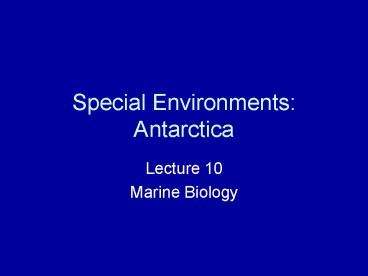Special Environments: Antarctica PowerPoint PPT Presentation
1 / 46
Title: Special Environments: Antarctica
1
Special Environments Antarctica
- Lecture 10
- Marine Biology
2
- Antarctica
3
Introduction
Polar communities in shallow water differ from
other communities - drastic seasonal changes in
light - ice and snow - constant extremely low
temperatures
4
(No Transcript)
5
Arctic vs. Antarctic
- Arctic and Antarctic have very different physical
parameters - - leads to different communities
- Arctic
- Isolated Sea surrounded by land masses
- Extensive continental shelf
- Extensive river input
- Mainly sedimentaty benthic communities
6
Arctic vs. Antarctic cont.
- Antarctic
- Circumpolar ring of water surrounding central
landmass - No rivers to produce sediment
- Narrow continental shelf with steep drop off
7
Benthic Biology in Polar Seas - Arctic and
Antarctica
Physical differences Arctic more restricted with
pack ice always present, also riverine input
from North American and northern European rivers
compared to pack ice breakup in the austral
summer and no riverine input.
8
Ice
Ice is a major disturbance factor in both Arctic
and Antarctic regions - destroys benthos by
freezing, lifting, or gouging
9
Geography
- Seasonal differences contrast between the
Arctic and the Antarctica where productivity is
higher in the Antarctic - Productivity high year-around in Antarctic but
seasonal in Arctic. - Shallow water present in Antarctica not in the
Arctic region - Anchor ice important in Antarctica.
10
Antarctica Seafloor
11
(No Transcript)
12
Currents
13
Oceanographic Features
14
Anchor Ice
15
Dominant Flora and Faunaof the Arctic
16
Antarctic Organisms
Antarctic organisms are more biologically diverse
than Arctic - higher degree of endemism
17
Species Patterns
18
Sea Ice Formation
- Adaptations
- Fish with antifreeze compounds
- glycoproteins prevent freezing of body fluids
when temperature falls below freezing. - Lack of blood pigments in some fishes due to
hypersaturation of water O2 levels and low
metabolic rates - simply diffusion sufficient.
19
Species Assemblages
20
(No Transcript)
21
(No Transcript)
22
(No Transcript)
23
(No Transcript)
24
Food Webs
Associated with sea ice is a set of organisms
from bacteria to krill - well developed
microbial food web that is significant to
both the water column and the benthos
25
Krill
Antarctic seas are characterized by the central
position and importance of the krill, Euphasia
superba
26
Krill
27
Krill, cont.
Above krill swarms Left Whale feeding on
krill
28
Antarctic Research
- Research conducted in Antarctica to
reconstruct climate change from ocean sediments
29
Zonation of Benthic Communities in Antarctica
Zone 1 0-15 m, essentially devoid of bottom
life because of scouring by sea ice, anchor
ice. Zone 2 15-30 m, sessile organism, some
anchor ice Zone 3 30m and deeper, no ice,
sponges, sea stars dominate, representatives of
all invertebrate phyla. System appears to be
regulated by physical factors, organism slow
growing - fragile system.
30
Vertical Zonation
31
Sea Ice Microbial Community - unique to polar
regions
- Diatoms are the biggest component
- - base of food chain during the over-wintering
period - provides food to benthic community via
fall out from the ice. - Major differences between Arctic and Antarctic
communities - 1 - Antarctica has huge populations of krill -
Euphausia superba (crustacean shrimp-like
organism). This is due to upwelling south of the
Antarctic Convergence Zone. Krill are a major
source of food for vertebrates - eg. whales,
seals, penguins, and other vertebrates. - 2 - Dense populations of benthic organisms -
large, long-lived communities - why? - 1st - no large organisms to feed on them, in
Arctic - walruses, gray whales feed on benthic
communities. - 2nd - long-lived adults - many reproductive
events in life- time.
32
Benthic Soft Bottom communities
Composed mainly of burrowing and tube-building
polychaetes and small crustaceans Dominated by
large and long-lived species No evidence of a
competitive dominant
33
Benthic soft bottom, cont.
Polychaetes, anemones, and soft corals
34
Benthic soft bottom, cont.
Brittle stars, crinoids, and entoprocts
35
Hard Bottom Communities
Antarctica houses a surprising variety of
organisms in hard bottom communities that include
some limited representatives of most major phyla.
Sponges and corals both exist in Antarctica
36
Hard bottom species, cont.
37
(No Transcript)
38
(No Transcript)
39
(No Transcript)
40
Pelagic communities
41
(No Transcript)
42
Land and Marine Mammals
43
(No Transcript)
44
(No Transcript)
45
And even a few plants and algae!
46
Next class Video documentary of Antartica

